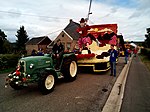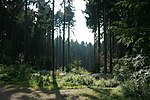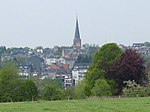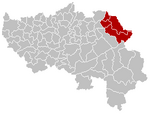Hammer Bridge

The Hammer Bridge is a 220 metres (722 ft) long railway bridge on the Weser Valley line crossing the Geul valley a few hundred meters to the south of Hergenrath. Today it is in the German speaking part of Belgium. Before frontier changes mandated in 1919 shifted the frontier between Belgium and Germany approximately 36 km (23 miles) along the railway line in a southerly direction the bridge was in Germany. Back in 1841 when work started on the first railway bridge at this point, it was located in the Rhine Province of Prussia.The bridge was replaced twice, most recently in 1997/99 in order to take the extra weight of the new high-speed train route into which the bridge has now been incorporated.
Excerpt from the Wikipedia article Hammer Bridge (License: CC BY-SA 3.0, Authors, Images).Hammer Bridge
Hammertreppe,
Geographical coordinates (GPS) Address Nearby Places Show on map
Geographical coordinates (GPS)
| Latitude | Longitude |
|---|---|
| N 50.703444444444 ° | E 6.0471111111111 ° |
Address
Hammerbrücke
Hammertreppe
4730 (Hauset)
Liège, Belgium
Open on Google Maps











